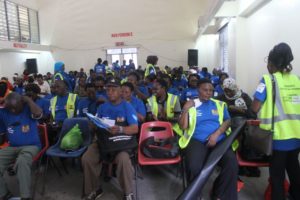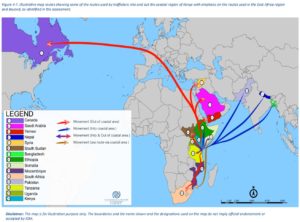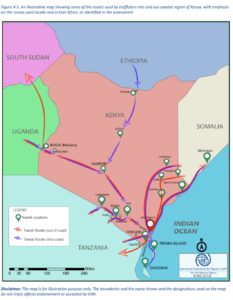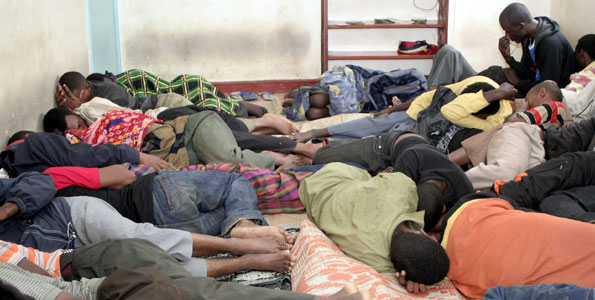By Winnie Kamau
Kenya’s coastal region is on the sport again after a shocking report on human traffic was recently released.
As the world marked the World Against Trafficking in Persons Day on 30th July 2018, the spotlight was shone on one key hotspot, due to the numerous media exposes.
The media exposure did not fall on deaf ears and it necessitated a research to be conducted to confirm the data and the reality on the ground. A joint report by the International Organization for Migration (IOM) and the Government of Kenya was released during the celebrations which were held in Mombasa.
The Report dubbed, Assessment on Human trafficking situation in the Coastal Region of Kenya sheds light on some of the key reasons for human trafficking which include the high rate of unemployment in the country.

In acknowledging the report, IOM’s Chief of Mission, Michael Pillinger noted: “This assessment fills a critical gap, as the coastal region of Kenya is a hotspot for trafficking, requiring updated and timely information on the latest trends”.
According to the report which focused on the Coastal Cities of Mombasa, Kwale, and Kilifi, showed that in 2014, 17,752 victims of human trafficking were detected in 85 countries. Barely 2 years later in 2017, the International Labour Organization (ILO) estimated there were 24.9 million victims worldwide.
The report shows that Globally Human trafficking is a big business as it earns profits of approximately 150 billion USD a year for traffickers. Kenya has been identified as a source, transit and destination country for Victims of Trafficking (VOTs) subjected to forced labor and sex trafficking.
IOM, the United Nations Migration Agency, has documented that internal trafficking occurs within Kenya mainly for purposes of domestic labor and sexual exploitation, while international or cross-border trafficking occurs for purposes of forced labor, domestic servitude, and sexual exploitation.
 The report also shows that Kenyans are increasingly migrating to the Middle East including Lebanon, Kuwait, Qatar, Saudi Arabia and the United Arab Emirates (UAE) in search of employment, often through legal or illegal employment agencies, and they are sometimes exploited in domestic servitude, massage parlors, brothels or forced manual labour.
The report also shows that Kenyans are increasingly migrating to the Middle East including Lebanon, Kuwait, Qatar, Saudi Arabia and the United Arab Emirates (UAE) in search of employment, often through legal or illegal employment agencies, and they are sometimes exploited in domestic servitude, massage parlors, brothels or forced manual labour.
According to Anita Nyanjong a Program Officer, at Equality Now, “Kenya is one of the countries with growing sex tourism occurring in the context of a booming tourism industry and increased foreign investment which contributes to the greater movement of people, sex buyers included.”
Rwanda, Burundi, Somalia, Tanzania, and Uganda. There are reported cases of women from India and Nepal recruited to work in dance clubs in Nairobi and Mombasa who are forced to pay off debt by dancing and through forced prostitution and situations of debt bondage.
 Moreover, the influx of refugees at Kakuma and Dadaab camps in Kenya has increased
Moreover, the influx of refugees at Kakuma and Dadaab camps in Kenya has increased
vulnerability to trafficking, smuggling and other forms of exploitation. Nairobi, the coast, and Western Kenya are known as destinations for internal trafficking.
Ultimately, the coastal region of Kenya has been known as a hotspot area for human trafficking as well as for irregular migration. However, there is little data available and there is a lack of programming targeting trafficking in these regions. It is against this background that this assessment has been conducted.
Sexual exploitation of both men and women in coastal Kenya is taking place in unregulated cottages and villas. Moreover, sexual exploitation of children in coastal areas is prevalent and a reflection of the profound risk potentially faced by all children in Kenya. An estimated 10,000 to 15,000 girls living in Diani, Kilifi, Malindi, and Mombasa are involved in casual sex work – up to 30% of all 12 to 18-year-old girls living in these coastal areas.
The major Trafficking Routes identified in the report for Girls in the coastal areas of Kenya are often recruited for jobs in the Gulf through hair salons and restaurants but are subsequently exploited on arrival. Girls are particularly vulnerable to trafficking for sex tourism.
The most recently identified routes for cross-border trafficking are to the Middle East while another route of importance is the corridor towards Southern Africa. Ethiopian and other
irregular migrants typically cross the border into Kenya near Moyale, then travel to Marsabit, Isiolo or Nanyuki before arriving in Nairobi. From the capital, they move toward South Africa or Botswana via road.
Upon entry into Kenya, many of these individuals are connected to smugglers who can move them to Tanzania onwards. Smuggled migrants are vulnerable to trafficking, and smuggled migrants along the Southern route have reported the kidnapping, extortion and labor and sexual exploitation, blurring the lines between smuggling and trafficking.
According to the United Nations Office on Drugs and Crime(UNODC), Global Report on Trafficking in Persons, sexual exploitation is by far the most commonly identified form of human trafficking stands at 79%, followed by forced labor at 18%. Worldwide, it is estimated that almost 20% of all trafficking victims are children.
In 2014, four in 10 detected victims were used for forced labor and 63% of this group were men. While sexual exploitation and forced labor are the most prominent forms of trafficking, victims are also exploited in other ways including being used as beggars, child soldiers, forced marriages, benefit fraud, production of pornography or for organ removal.
The Government of Kenya has been urged to create job opportunities for the youths and also increase literacy levels through accessible and affordable educational systems. This will go along way in helping reduce Human trafficking in the Coasatal region.














